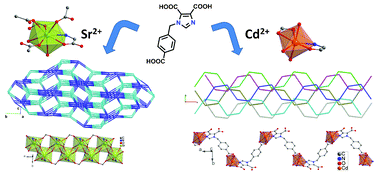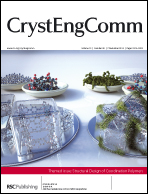This article presents the investigation of the coordination behavior of a newly synthesized tricarboxylate ligand, obtained by joining imidazole dicarboxylic acid and 4-carboxybenzyl moieties [cbimdaH3, 1-(4-carboxybenzyl)-1H-imidazole-4,5-dicarboxylic acid]. Two novel coordination polymers were obtained through solvothermal reactions under similar conditions namely [Sr(cbimdaH)(H2O)]n (1) and [Cd2(cbimdaH)2(H2O)6]n·(DMF)3n(H2O)3n (2), with the ligand behaving as a dianionic tricarboxylate linker. The single crystal X-ray structures show that while 1 forms a 3D coordination polymer, 2 forms a 1D polymer which is further assembled in three dimensions through supramolecular interactions (H-bonding). Complex 1 consists of Sr2+ ions in a distorted dodecahedral coordination geometry, while 2 consists of Cd2+ ions in distorted pentagonal bipyramidal geometries. A topology study reveals that 1 has a new topology based on the 5,6-coordinated 3D net architecture. The luminescence properties of the complexes in the solid state and their thermal stabilities were studied.

You have access to this article
 Please wait while we load your content...
Something went wrong. Try again?
Please wait while we load your content...
Something went wrong. Try again?


 Please wait while we load your content...
Please wait while we load your content...